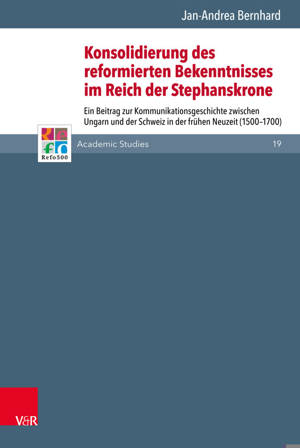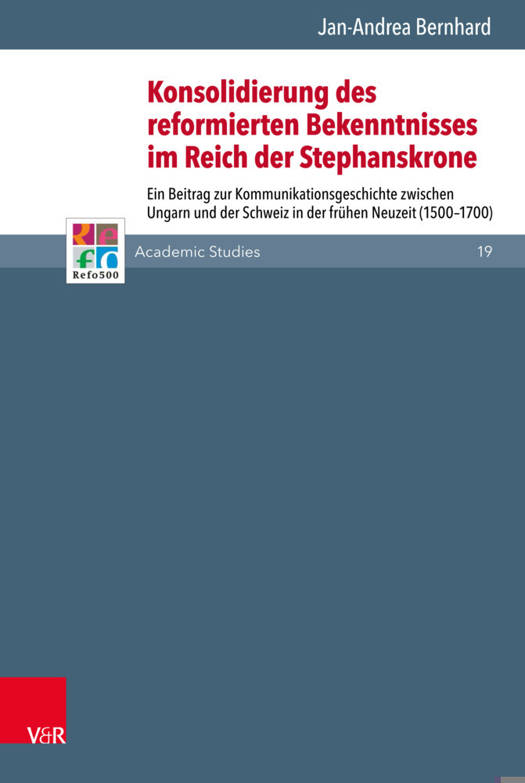
- Retrait gratuit dans votre magasin Club
- 7.000.000 titres dans notre catalogue
- Payer en toute sécurité
- Toujours un magasin près de chez vous
- Retrait gratuit dans votre magasin Club
- 7.000.0000 titres dans notre catalogue
- Payer en toute sécurité
- Toujours un magasin près de chez vous
Konsolidierung Des Reformierten Bekenntnisses Im Reich Der Stephanskrone
Ein Beitrag Zur Kommunikationsgeschichte Zwischen Ungarn Und Der Schweiz in Der Fruhen Neuzeit (1500-1700)
Jan-Andrea Bernhard
222,45 €
+ 444 points
Description
English summary: Jan-Andrea Bernhard analyzes the historical connections between Switzerland and Hungary in the 16th and 17th centuries. The current state of scholarship requires an explanation of why the Hungarian Reformation sided with the Helvetic Confession for the most part, while its reformist contacts in Germany had been intensively and widely established. Consequently, Bernhard assesses the source material and scholarly literature in new ways by using interregional and interlinguistic approaches in an extensive way. Bernhard's analysis of the source material was led by the communications-historical question of how the exchange of information between Switzerland and Hungary was carried out in the early modern period. The results of this investigation de-mythologizes Hungarian (church-)historical writing in several respects. The research establishes that up to the middle of the 16th century the studia humanitatis and reformatio had not been divided, which meant that from its beginnings the Hungarian Reformation was not Lutheran, but represents a via media in terms of Melanchthon, Calvin, and others. Moreover, the consolidation of the Helvetic Confession in Hungary was attested not only to the reception of the Confessio Helvetica posterior (The Second Helvetic Confession-1566), but also essentially to the great diffusion of Reformation works associated with the Confession (Calvin, Bullinger, de Beze, Gwalther, etc.) which lasted into the 17th century. Finally, the theological contact and Reformed ties essentially dominated the diaconal engagement in support of the persecuted Protestants in Hungary in the time of Absolutism, so that Reformed orthodoxy reached its zenith at the end of the 17th century. With this work, Bernhard has achieved a milestone in the scholarly literature regarding the historical connections between Hungary and Switzerland. German description: Jan-Andrea Bernhard untersucht die Beziehungsgeschichte zwischen der Schweiz und Ungarn im 16. und 17. Jahrhundert. In der Forschung ungeklart ist die Frage, warum die ungarische Reformation sich in ihrer Mehrheit dem helvetischen Bekenntnis angeschlossen hatte, obwohl sich die reformatorischen Kontakte nach Deutschland weit intensiver gestaltet haben. Daraufhin untersucht Bernhard das Quellenmaterial und die Forschungsliteratur erstmals lander- und sprachubergreifend in umfassender Weise. Bei der Beschaftigung mit dem Quellenmaterial war die kommunikationsgeschichtliche Fragestellung, wie sich der Wissenstransfer zwischen der Schweiz und Ungarn in der Fruhen Neuzeit gestaltete, leitend.Die Untersuchung entmythologisiert die ungarische (Kirchen-)Geschichtsschreibung in mehreren Bereichen. So kann nachgewiesen werden, dass bis Mitte des 16. Jahrhundert studia humanitatis und reformatio nicht getrennt wurden, die ungarische Reformation in ihren Anfangen keine lutherische war, sondern eine via media im Sinne Melanchthons, Calvins oder anderer vertrat. Weiter ist die Konsolidierung des helvetischen Bekenntnisses in Ungarn nicht nur der Rezeption der Confessio Helvetica posterior (1566) zuzuschreiben, sondern wesentlich auch der grossen Verbreitung von reformatorischen Helvetica (Calvin, Bullinger, de Beze, Gwalther, usw.), welche bis in das 17. Jahrhundert anhielt. Schliesslich haben theologische Kontakte und reformierte Verbundenheit das diakonische Engagement zugunsten der verfolgten Protestanten in Ungarn zur Zeit des Absolutismus wesentlich beherrscht, so dass die reformierte Orthodoxie in Ungarn Ende des 17. Jahrhunderts ihren Hohepunkt erreichte. Mit dieser Arbeit gelingt Bernhard ein Meilenstein in der Fachliteratur zur Beziehungsgeschichte zwischen Ungarn und der Schweiz.
Spécifications
Parties prenantes
- Auteur(s) :
- Editeur:
Contenu
- Nombre de pages :
- 800
- Langue:
- Allemand
- Collection :
- Tome:
- n° 19
Caractéristiques
- EAN:
- 9783525550700
- Date de parution :
- 16-01-17
- Format:
- Livre relié
- Format numérique:
- Genaaid
- Dimensions :
- 168 mm x 236 mm
- Poids :
- 1256 g

Les avis
Nous publions uniquement les avis qui respectent les conditions requises. Consultez nos conditions pour les avis.






